Abstract
With the natural evolution of the Arctic route and advancements in related technologies, the development of new green ice-class ships is becoming a key technological breakthrough for the global shipbuilding industry. As a special vessel form that must perform icebreaking operations and undertake long-distance ocean voyages, an ice-class ship requires sufficient icebreaking capacity to navigate ice-covered water areas. However, since such ships operate for most of their time under open water conditions, it is also crucial to consider their resistance characteristics in these environments. Firstly, this paper employs linear interpolation to extract wind, wave, and sea ice data along the route and calculates the proportion of ice-covered and open water area in the overall voyage. This provides data support for hull form optimization based on real sea state conditions. Then, a resistance optimization platform for ice-class ships is established by integrating hull surface mixed deformation control within a scenario analysis framework. Based on the optimization results, comparative analysis is conducted between the parent hull and the optimized hull under various environmental resistance scenarios. Finally, the optimization results are evaluated in terms of energy consumption using a fuel consumption model of the ship’s main engine. The optimized hull achieves a 16.921% reduction in total resistance, with calm water resistance and wave-added resistance reduced by 5.92% and 27.6%, respectively. Additionally, the optimized hull shows significant resistance reductions under multiple wave and floating ice conditions. At the design speed, calm water power and hourly fuel consumption are reduced by 7.1% and 7.02%, respectively. The experimental results show that the hull form optimization process in this paper can take into account both ice-region navigation and ice-free navigation. The design ideas and solution methods can provide a reference for the design of ice-class ships.
1. Introduction
With the increasing attention paid to Arctic environmental protection, the impact of ship emission requirements on the overall design is no less than the impact of external factors [1]. International Maritime Organization (IMO): The IMO has added energy efficiency rules for ships within the framework of the International Convention for the Prevention of Pollution from Ships (MAPOL., It aims to improve ship Energy Efficiency and reduce emissions through technical Efficiency [2] (Energy Efficiency Design Index, EEDI) and Operational efficiency [3] (Energy Efficiency Operational Index, EEOI). As a result, designers must give significant attention to energy consumption when conducting hull form design, ensuring that the vessel’s overall performance is maintained while minimizing its environmental impact.
An ice-class ship is a specialized vessel designed to perform icebreaking operations and undertake long-distance ocean voyages. In addition to requiring excellent icebreaking capabilities, it also needs to possess exceptional ocean voyage performance. Therefore, when designing an ice-class ship, it is necessary to combine the actual sea conditions of the route and consider the influence of various environmental resistances, such as calm water resistance, wave-added resistance, wind resistance, and crushed ice resistance [4].
In terms of data collection, European and American countries have conducted extensive and in-depth research on sea ice, including studies on Arctic sea ice extents, sea ice concentration, and sea ice thickness. In contrast, due to the influence of Arctic policy, research in China has primarily focused on sea ice observation and data processing. For example, Chen et al. [5] used numerical simulation methods to predict future sea ice conditions in various Arctic regions over the coming decades and provided a navigability feasibility assessment. Landy et al. [6] analyzed interannual trends and variations in sea ice thickness and volume across multiple regions of the ECA, based on sea ice thickness data from CryoSat-2 and ICESat, as well as thin ice thickness observations from the SMOSL band radiometer. Ji et al. [7] conducted an in-depth study on ice thickness, sea ice concentration, and ice extent using CryoSat-2 data to improve the accuracy of satellite-derived ice parameters.
There has been extensive research conducted by scholars both domestically and internationally on wave data that includes the Arctic region. EareI [8] derived an empirical formula for the relationship between wind speed and dividing frequency using the PM spectrum, which was then applied to separate wind waves from surge waves. Yang Jungang et al. [9] based on their analysis of on-orbit multi-source satellite remote sensing data, investigating spatial and temporal coverage and determining that altimeters like CryoSat-2 can enable sea wave remote sensing observation in the Arctic region. Multi-satellite joint observations can provide effective wave height data, while multi-source scatterometers and altimeters can detect the sea surface wind field in the Arctic.
With the development of computer technology, the CFD method based on the Reynolds-averaged Navier-Stokes (RANS) equations has rapidly become an important means of numerical simulation of ships [10]. For example, Fujii et al. [11] calculated the wave added resistance of a full-form ship under oblique wave conditions. The numerical results agreed well with experimental data, except for a slight underestimation in shortwave cases. Joncquez et al. [12] employed a high-order Rankine source method to compute wave added resistance under a fixed field potential, combining the laminated flow hypothesis and the Newman–Kelvin hypothesis. Seo et al. [13] used the section cutting method, the Cartesian grid method, and the Rankine source method to study the wave added resistance of the Wigley hull, the S60 series, and the S175 container ship under shortwave conditions. Dai Yishan et al. [14] improved the far-field formula originally proposed by Maruo by deriving it directly using a near-field formula, significantly simplifying the derivation process and improving computational efficiency.
In the context of hydrodynamic performance optimization for ships, optimization algorithms, potential flow theory, and computational fluid dynamics (CFD) have greatly advanced simulation-based design (SBD) methodologies. These developments have significantly transformed the process of optimizing ship hydrodynamic performance [15,16]. Pinto [17] performed an optimization of the bulbous bow form of a tanker using a combination of potential flow theory and empirical formulas, with the ship’s total resistance as the objective function. Duan Fei [18] focused on a fully parameterized polar tanker, optimizing three different bow forms, and validated the feasibility and effectiveness of a polar ship multi-objective optimization method based on the NSGA-II algorithm. Cheng Hongrong [19] took a polar tanker as the research subject and developed an integrated multi-objective optimization scheme, using icebreaking navigation efficiency, relative turning diameter, and EEDI as the objective functions.
With the rise of polar transportation and growing attention to fuel economy, the hydrodynamic resistance performance of icebreaker-form hulls has increasingly attracted attention [20]. For example, RUPP et al. [21] and KIM et al. [22] studied the impact of bow shape on the ship’s hydrostatic navigation ability and icebreaking capacity and designed bow forms that balance both icebreaking performance and open water resistance. Their designs were validated through model tests. Gu Zhuhao [23] carried out a fully parameterized configuration design for the bow of polar ships and developed an integrated hull optimization system that considers both resistance performance and ice-resistant performance under various ice and wave conditions. Wang Shichao et al. [24] used CFD and coupled CFD and DEM methods to compute calm water resistance and crushed ice resistance and further applied an XGBoost model combined with the NSGA-III algorithm for optimization. The approach was validated using the KCS standard hull form. Pan Liguang [25] used the method of parametric model to deform the existing hull form. For the two optimization objectives of calm water resistance and crushed ice resistance, different ship deformation parameters were selected to enhance the targeted optimization. But in general, there is less research about the performance of ice-breakers under brash ice and open water conditions.
In summary, current multi-objective optimization and automatic optimization technologies for hull forms have become increasingly mature. However, most existing studies focus on optimizing single performance without taking into account the actual sea conditions along the route. Therefore, this study incorporates sea condition data collected along the Arctic Northeast Passage and establishes a total resistance optimization platform for ice-class ships under various ice and wave conditions. A hull form optimization approach is proposed that considers both open water performance and navigation efficiency in ice-covered regions, aiming to explore drag reduction and energy consumption issues along the route for ice-class ships. The main contributions of this study are as follows:
- (1)
- Wind, wave, and ice condition data along the route are extracted using linear interpolation, and the proportion of the voyage in ice rind zone and ice-free area is calculated, along with the corresponding proportion of sea state in each area. These provide essential data support for hull form optimization based on actual sea conditions.
- (2)
- Based on a scenario analysis framework integrated with mixed deformation control of the hull surface, an optimization algorithm is introduced to construct a total resistance optimization platform for ice-class ships operating in multi-ice and multi-wave environments. Significant changes in the hull form are analyzed based on the optimization results, and comparative analyses are conducted between the parent hull and the optimized hull under various environmental resistance conditions.
- (3)
- A fuel consumption model of the ship’s main engine is developed to evaluate energy consumption differences caused by the hull design modifications.
2. Processing of Meteorological Elements in the Target Vessel’s Route Sea Area
2.1. Target Ships and Routes
A fully parameterized model was developed for a 36,000 ton multi-purpose ice-class vessel, as shown in Figure 1. The principal dimensions of the vessel and its corresponding model are listed in Table 1.

Figure 1.
Schematic diagram of the target ship.

Table 1.
Parameters related to the target vessel.
Figure 1 shows a schematic diagram of a multipurpose ice-class ship on which all calculations and optimization processes are implemented.
In this study, the target vessel transports over 30,000 cubic meters of wind power equipment, departing from Lianyungang and passing through the Yellow Sea and the Korea Strait into the Sea of Japan. It then transits the Soya Strait into the Sea of Okhotsk and crosses the Bering Strait to enter the Arctic Ocean. Within the Arctic Ocean, the vessel follows a central route, sailing through the Chukchi Sea and transiting the De Long Strait into the East Siberian Sea. It then proceeds north of the East Siberian Islands into the Laptev Sea, where ice conditions are particularly severe. Continuing westward, the vessel passes through the Vilkitsky Strait into the Kara Sea, then moves further west via the northern coast of Novaya Zemlya into the Barents Sea and Norwegian Sea, ultimately reaching its destination port in Europe. The full route is illustrated in Figure 2.
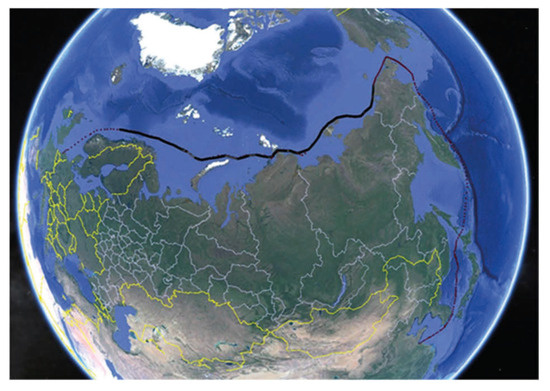
Figure 2.
Target ship trajectory.
2.2. Meteorological Dataset
The European Centre for Medium-Range Weather Forecasts (ECMWF) is one of the world’s leading meteorological research institutions, providing a wide range of high-precision meteorological datasets covering the period from 1979 to the present. In this study, the ERA5 reanalysis model (ECMWF Reanalysis v5), developed by ECMWFs Copernicus Climate Change Service (C3S), is selected as the source of wind–wave meteorological data. ERA5 is the fifth-generation global atmospheric reanalysis dataset, covering the period from January 1940 to the present, and features a spatial resolution of approximately 30 km. It has replaced the previous ERA-Interim reanalysis model.
The ERA5 model applies the principle of data assimilation, combining model outputs with observations from around the world based on physical laws, to produce a consistent and globally comprehensive dataset. The ERA5 dataset spans several decades and provides daily quantitative summaries of seven key climate reanalysis parameters, including the U-component of wind at 10 m, the V-component of wind at 10 m, air temperature at 2 m, dew-point temperature at 2 m, total precipitation, mean sea level pressure, and surface pressure. The ERA5 data includes both hourly and daily temporal resolutions. For ease of use in climate applications, monthly aggregated datasets are also available under different data types.
The dataset used in this study is a regridded subset of the full-resolution ERA5 archive. It provides global horizontal coverage, with a spatial resolution of 0.25° × 0.25° for atmospheric reanalysis and 0.5° × 0.5° for wave reanalysis. The data have been regridded onto a regular latitude–longitude grid and stored in Network Common Data Form (netCDF) format. Python (version 3.10.6) was used to download and read the .nc files and to extract the corresponding meteorological target values based on longitude, latitude, and time. The relevant dataset is shown in Table 2.

Table 2.
Wind and Wave Dataset.
Since the ERA5 model provides the U- and V-components of wind at 10 m above sea level, it is necessary to perform vector synthesis of the U and V components at the same time and within the same geodetic coordinate system to obtain the corresponding wind speed and wind direction. The synthesis result is shown in Figure 3.
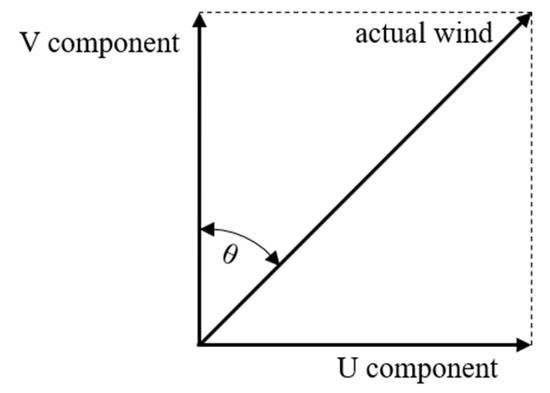
Figure 3.
Schematic diagram of wind data synthesis.
The U-component and V-component represent the wind speed components at 10 m above sea level in the longitudinal and latitudinal directions, respectively. When the wind is blowing due north, the V-component is positive; when blowing due south, the V-component is negative. Similarly, when the wind is blowing due east, the U-component is positive, and when blowing due west, the U-component is negative. By applying vector synthesis to the U and V values, the true wind vector can be obtained, with its magnitude representing the actual wind speed. The wind direction angle θ is defined as 0° for wind coming from the north and increases clockwise within the range of 0° to 360°.
In the wave meteorological dataset, land areas are marked with “NaN” values to indicate the absence of wave height data in those regions.
Sea ice conditions are typically evaluated based on sea ice thickness and sea ice concentration. Sea ice thickness refers to the depth of the ice layer. In Arctic shipping systems, sea ice is classified into nine types according to its thickness, as shown in Table 3.

Table 3.
Sea ice thickness classification.
Sea ice concentration is defined as the ratio of the ice-covered area to the total sea area. Based on the concentration range, it is categorized into eight types, as shown in Table 4.

Table 4.
Ice density type.
This study considers sea ice concentration and sea ice thickness based on multi-source ice data. The sea ice datasets used should be obtained from relatively stable and open-access databases. The data source is shown in Table 5.

Table 5.
Sea Ice Dataset.
2.3. Dataset Extraction and Weighting Allocation
In this study, a linear interpolation fitting method is used to perform spatial matching with the data points from the meteorological dataset in order to obtain the sea state data along the target route and the corresponding coverage ratio [23]. The meteorological data extraction process is as follows:
- (1)
- Given n initial route points and the latitude–longitude span of the route, the meteorological dataset is filtered based on this geographical range, as shown in the formula:
In the above expression, Lon(i) and Lat(i) represent the longitude and latitude of the meteorological data points, respectively; L(i) denotes the set of data points within the latitude–longitude span of the route; and ILon(i) and ILat(i) represent the longitudes and latitudes of the data points within this span that are associated with the route.
- (2)
- After extracting the meteorological data within the route’s latitude–longitude span, linear interpolation fitting is applied to the route data points. For each pair of adjacent points, the segment is projected in the longitudinal direction, and a new fitted point is inserted every x interval. The fitting schematic diagram is shown in Figure 4.
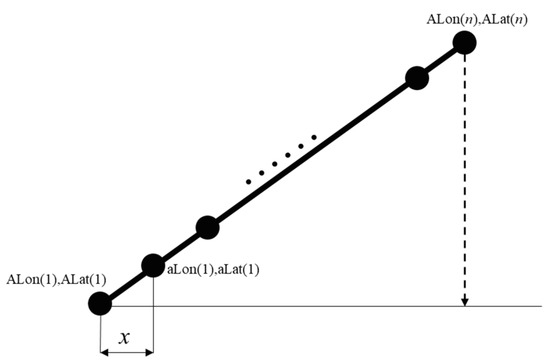 Figure 4. Schematic diagram of fitting.
Figure 4. Schematic diagram of fitting.
The formula is as follows:
In the formula, aLon(i) and aLat(i) represent the longitude and latitude of the fitted route data points, respectively. ALon(i) and ALat(i) denote the longitude and latitude of the initial route data points, respectively.
- (3)
- Define a data extraction range for fitted data points and extract meteorological data points within this range from L(i). The formula is as follows:
In the formula, CLat(i) and CLat(j) represent the longitude and latitude of all route data points, respectively. NP(i) denotes the meteorological data points within this region.
- (4)
- After extracting meteorological data within the flight route range, perform averaging processing. This paper assumes this mean value as the meteorological value at a specific point on the route:
In the formula, At(i) represents the meteorological value at each route data point. t(m) denotes the meteorological value within the extraction range corresponding to the route data point.
In this paper, the sea ice data are extracted and processed first, and the non-ice area and ice area on the route are divided according to the results of the sea ice extraction data. On this basis, other meteorological data in the non-ice area and ice area are extracted.
It is necessary to calculate the weight proportion of meteorological data for the subsequent optimization calculation of ship shape in this paper. The steps are as follows:
- (1)
- It is divided according to the proportion of non-ice areas and ice areas on the route to the total voyage. The formula used is as follows:
In the formula, Dj represents the length of a sub-voyage segment in the ice zone. IL denotes the total ice zone voyage length. T is the total voyage length. and represent the voyage proportion of the ice zone and open water area, respectively.
- (2)
- The meteorological proportion of non-ice area and ice area is divided respectively. In order to obtain the meteorological value Qi, Pi is divided into s ranges with the boundary, and the ratio ωi of the number of meteorological data points to the total number of data points w in the similar range is obtained. ωi is used as the corresponding weight.
3. Mixed Deformation Control for the Whole Hull Surfaces
3.1. Full Parameterization Model of the Stern and Tail Fin
The characteristic parameters and characteristic curves determine the main contour of the hull-generated surface. The transverse and longitudinal curves of the hull are expressed in a parametric way. Straight lines, B-spline curves, F-spline curves, etc., are used to effectively control the hull surface generated based on parameterization, reduce the complexity caused by parameter input, and improve the model’s flexibility and appearance quality. In this paper, the stern and tail fins of the target ship are fully parametrically modeled and constructed and deformed based on the characteristic parameter curve. The design process is shown in Figure 5.
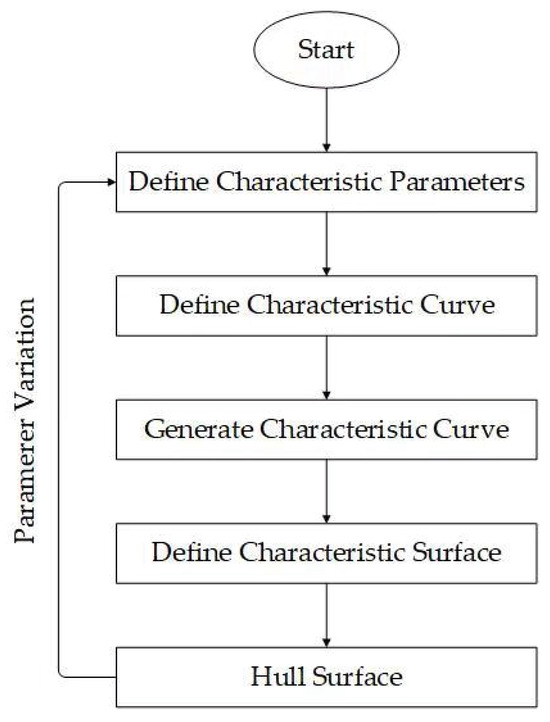
Figure 5.
Hull parametric modeling process.
For the stern surface modeling, the surface skinning is performed along the X direction, and the feature definition of the tail area is selected in the YZ plane. The stern cross-section frame is expressed by the bottom, bilge, and side. The side is defined by the deck sideline and flat sideline. Each X corresponds to a YZ section side curve, and its starting and ending coordinate Y values are both half-width values of the hull; the starting coordinate Z value is assigned by the flat edge, and the ending coordinate Z value corresponds to the hull depth value. The bottom of the ship is defined by the bottom line and the keel line. Each X corresponds to a YZ profile bottom curve, and its starting point coordinate Y value is 0. The Y value of the endpoint coordinate is given by the horizontal bottom line, and the Z value of the start and endpoint coordinates is defined by the keel line height. A schematic diagram is shown in Figure 6.
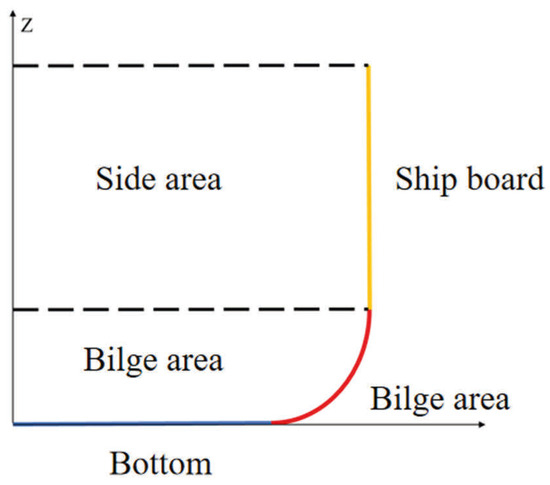
Figure 6.
Schematic diagram of the cross-sectional frame.
F-Spline is used to define the bilge curve, the tangent angles of the starting and ending positions, and the fullness of the bilge to ensure that the bottom, bilge, and side are smoothly connected and smoothly connected with the front hull. To assign the Y value coordinate of the flat bottom line in the YZ plane, the flat bottom line needs to be rotated 90 degrees around the X axis so that it is located on the XZ plane. This ensures that the X of each curve equation in the subsequent Curve Engine can correspond to a Z value, thereby assigning the corresponding parameters to the Feature Definition to achieve the purpose of generating the hull surface. The basic curve of the stern form is shown in Table 6.

Table 6.
Basic curves of stern form.
The tail fin surface modeling is constructed through B-spline surface. Two B-spline curves are created respectively. The XY plane is selected as the defined plane. Each B-spline curve consists of 6 points. The coordinate relationship between the points is expressed by mathematical functions. The weight distribution and knot vector distribution of each point are manually defined to meet the full-parametric expression of the tail fin surface and the full-parametric control of the tail fin surface by controlling the B-spline curve.
In addition, to make the target ship’s stern section and the tail fin intersect smoothly, this paper constructs the tail fin plane contour line in the XY plane and finds the mathematical relationship between the contour line’s horizontal coordinate and the ship’s length Lpp. Firstly, we project the contour line to the stern of the hull to obtain the intersection line between the stern and the tail fin, and then translate the contour line along the normal direction and project it to the stern to obtain another intersection line for auxiliary smooth connection and an auxiliary cut-off excess surface. Since the tail fin surface has high geometric complexity, it is necessary to construct additional characteristic curves to achieve accurate mathematical representation and description of it. The relevant characteristic curve information required for tail fin modeling is shown in Table 7.

Table 7.
Basic curves of skeg form.
The curve generation engine (Curve Engine) is defined in the Feature programming language. Curve Engine uses the hull feature curve constructor framework curve and acts on the surface generation engine (Meta Surface). Full-parametric surface modeling is constructed through the Feature programming language, reference coordinate system, parametric feature curves, and hull geometric size parameters. The basic form curves and characteristic curves required for the stern and tail fin of the target ship and the generated fully parameterized stern and tail fin surfaces are shown in Figure 7 and Figure 8.
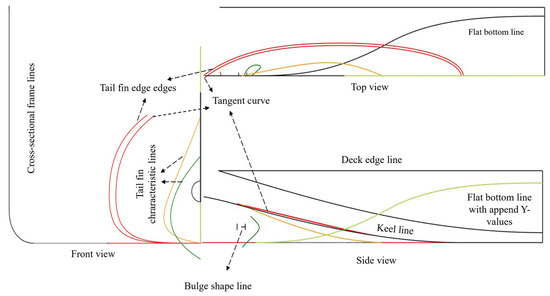
Figure 7.
Stern and skeg curve.

Figure 8.
Stern and skeg surface.
3.2. Delta Shift Deformation for Ship Bow
The target bow section includes a hidden bulbous bow. This paper adopts the Delta shift deformation method for this part, which can achieve local controlled deformation with fewer parameters based on the original hull. The longitudinal control interval, deformation increment, and deformation direction are determined by creating an F-spline curve to define the incremental control curve 1. To ensure the smooth deformation of the bow, the tangent angle of the starting position of the incremental control curve 1 is defined as 0°. Create multiple smooth curves to define incremental control curve 2 to determine the vertical control range, deformation increment, and deformation direction. To ensure that the hull bottom and the bow hull above the waterline are not distorted, the starting position Y of the incremental control curve 2 is 0, and the part of the incremental control curve 2 above the waterline is defined as a non-deformation increment. The influence factor of the incremental control curve in this paper is 1. The deformation control is shown in Figure 9.
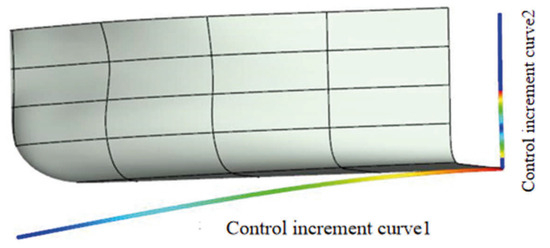
Figure 9.
Delta shift bow deformation control.
3.3. Improved Lackenby Method for Hull Form Deformation
For the main part of the target ship, this paper adopts improved Lackenby for semi-parametric control. Improved Lackenby uses B-spline curves instead of traditional quadratic polynomials, which can satisfy the hull deformation control while avoiding problems such as waterline extrusion and stretching at the exchange point of the deformed hull.
The SAC curve of the target ship for bow and stern deformation control is obtained through hydrostatic calculation, and the starting and ending positions of the front and rear of the hull are defined. The starting and ending tangent angles of the front and rear of the hull are calculated by improved Lackenby calculates the incremental offset function that meets a series of constraints, and the control points and node vectors of the B-spline curve are reasonably selected and set to avoid overfitting or underfitting.
The target ship is expressed by the fully parameterized tail, the bow deformed by delta shift, and the original parallel midbody segment. The whole is cut longitudinally to extract the offset set representing the hull geometry. The relevant still water numerical solution is performed when the draft is 11 m, and the original SAC curve of the target ship is extracted. The longitudinal center of buoyancy from midship Xcb and the prismatic coefficient Cp are parameterized, and the cross-sectional area of the target ship is interpolated using the incremental offset function to obtain the SAC curve of the deformed ship. The hull deformation control can be achieved by incrementally controlling the longitudinal center of buoyancy from midship Xcb and the prism coefficient CP, and improved Lackenby is adopted for the target ship as shown in Figure 10.
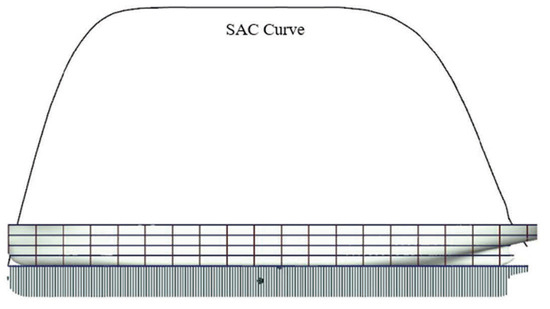
Figure 10.
Lackenby hull deformation control.
4. Optimized Design Methodology and Results
4.1. Establishment of Optimization Model
In order to effectively control the hull deformation and simplify the redundant control variables, this paper selects the target ship’s bulbous bow fullness (Bow-fullness), skeg-fullness, longitudinal center of buoyancy from midship (△Xcb), and prism coefficient increment (△Cp) as control variables to optimize the hull form. The design range of control variables is shown in Table 8.

Table 8.
Basic variables describing hull deformation.
The optimization target is determined by adopting a weight superposition strategy; the ratio analysis is shown in Figure 11. Based on the distribution of different ice conditions in the established routes, the corresponding distribution weights are mapped to the ice-breaking resistance. Similarly, according to the distribution characteristics of different wave conditions in the route interval, the corresponding weights are applied to the wave added resistance. Although the ship superstructure is not the target object of this optimization, the wind resistance is still included in the weighted consideration system and is comprehensively analyzed and processed as one of the weight factors. Since there are both non-ice areas and ice areas on the route, this paper performs distribution weighting on the open water area and ice area voyage and performs distribution weighting on different sea conditions in the waters and normalizes the weighted results to obtain the optimization target.
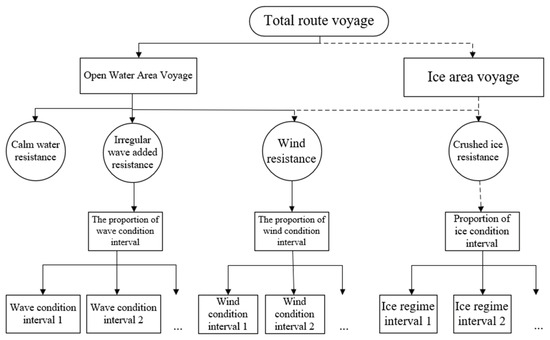
Figure 11.
Weight ratio analysis diagram.
The objective function F(x) is defined as follows:
The expression of R is as follows:
In the formula, R is the optimization objective; Rm and Ry represent the total resistance on the route for the original and optimized ship hulls, respectively; α and β represent the proportions of the open water and ice area on the route, respectively; and ai, bi, cj, and dj are the coefficients for different sea conditions.
After processing the meteorological elements in the sea area of the route, the average sea condition data of the target ship on the route in October 2019 can be obtained, and then the value of each parameter can be obtained. Due to the inhibiting effect of sea ice on waves, the wave sea state of the voyage in the ice area was not considered, and the sea state of the relatively small part of the voyage was combined, and various types of data were obtained as follows:
Results of the proportion of open water area voyage and ice area voyage are shown in Table 9.

Table 9.
Regional voyage proportion.
The results of the proportion of each sea state in the ice voyage are shown in Table 10, Table 11 and Table 12.

Table 10.
The proportion of ice conditions in the area.

Table 11.
The proportion of waves in the region.

Table 12.
The proportion of wind conditions within the area.
The results of the proportion of each sea state in the open water area are as follows:
The focus of this article is on the construction and verification of the optimization method. Appropriate tolerance is introduced in the data processing process to enhance the adaptability of the method, so the relevant numerical results are only used as a trend reference, not as an absolute indicator.
Rclam is the calm water resistance, Rwave is the wave-induced resistance, Rwind is the wind resistance, and Rice is the ice resistance.
The calculation method of the static water resistance of a ship during navigation is as follows:
In the formula, Rf represents the frictional resistance, Rr is the residual resistance, and Rap is the appendage resistance.
The wave resistance Rwave is calculated using the ship wave resistance formula proposed by Daidola [26], which solves for the axial mean wave force. The calculation method is as follows:
In the formula, represents the seawater density, g is the gravitational acceleration, L is the ship length, h is the wave height, χ is the wave direction angle, and Cx, Cy are the wave drift coefficients in the X-axis, Y-axis, and Z-axis directions, respectively.
The wind resistance Rwind is calculated using the numerical expressions for the longitudinal wind load coefficient, transverse wind load coefficient, and wind moment coefficient derived by Isherwood [27]. These expressions are based on parameters such as the waterline side projected area of the hull, ship length, waterline hull’s planform area, and ship beam, and are obtained through multiple linear regression. The calculation formula is as follows:
In the formula, Cx, Cy, and CN represent the wind load coefficients along the ship’s axes; vw is the relative wind speed, AT is the waterline above the hull’s planform area, AL is the waterline above the hull’s side projected area, and LOA is the ship length overall.
The ice resistance Rice is calculated using the multi-hull form universal ice resistance formula derived by Huang [28]. This formula is based on a large amount of experimental and simulation data from ships like KCS, JCS, AIV, and Araon, and the calculation method is as follows:
In the formula, ρice is the density of the broken ice, taken as 900 kg/m3; h is the sea ice thickness; D is the diameter of the sea ice’s upper surface; v is the ship’s speed; C is the ice concentration; and Fr is the Froude number.
The constraint conditions use the ship’s wetted surface area Wt and the ship’s drainage volume V. When the hull deformation meets the restriction conditions, the ship’s resistance is calculated. The constraint conditions are as follows:
4.2. Optimization Design Method
The ship form optimization process is implemented using the Sobol and NSGA-II combined optimization algorithm. This paper employs the Sobol algorithm as the core algorithm in the pre-sampling stage. It can generate initially uniformly dispersed sample points in the high-dimensional design space. Thereby, it deeply explores the complex relationships between design parameters and objective functions and accurately quantifies the sensitivity indicators of each design parameter, which significantly enhances the efficiency and precision of the optimization process. At the same time, the NSGA-II algorithm demonstrates excellent performance in the context of multi-objective optimization. It can effectively reconcile the inherent conflicts among different objective functions. Through a rigorous non-dominated sorting and crowding distance calculation mechanism, it stably converges to the Pareto optimal front and successfully obtains a series of representative Pareto optimal solutions, providing rich and scientific bases and alternatives for ship form optimization decisions. The specific optimization process is illustrated in Figure 12.
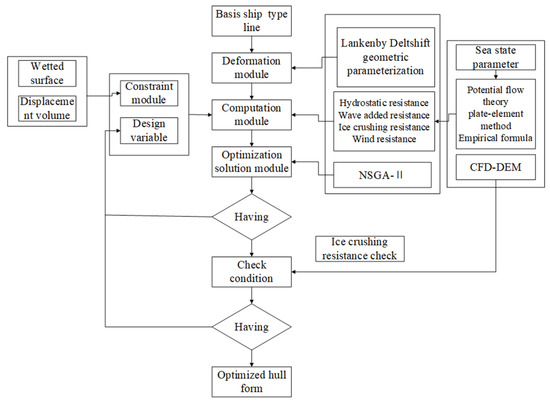
Figure 12.
Process of hull form optimization.
4.3. Hull Form Optimization Results
The bow fullness, tail fin fullness, increment of prismatic coefficient, and horizontal coordinates of floating center are taken as the design variables, and the optimization target R is represented by OPT. A 50 sample points are extracted within the sample space via the Sobol algorithm for the purpose of initial screening computation, and the specific sample selection outcomes are presented in Figure 13. As is discernible from Figure 13, the individuals selected by the Sobol method exhibit a uniform distribution within the sample space, thereby precluding the occurrence of sampling solely within certain localized regions and overlooking other potential design alternatives.
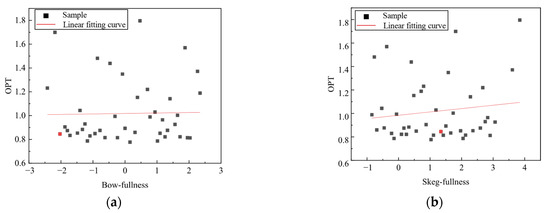
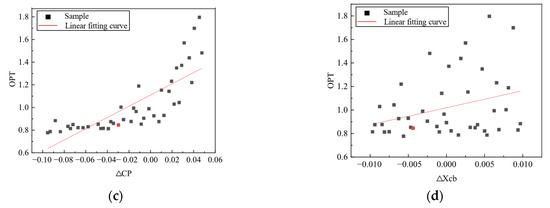
Figure 13.
The Sobol solution set distribution. (a) Optimization objective and Bow-fullness sensitivity; (b) Optimization objective and Skeg-fullness sensitivity; (c) Optimization objective and △CP sensitivity; (d) Optimization objective and △Xcb sensitivity.
The initial optimal target (red individual) among 50 spatial samples is obtained through the Sobol algorithm, and the sensitivity of each design variable can be obtained from the distribution of the Sobol solution set of each design variable and the objective function.
The range of the design variable pertaining to this objective is adopted as the initial value of the design variable under the NSGA-II genetic optimization algorithm for genetic iteration. The results can be seen in Figure 14. The size of the genetic population is set at 10, and the number of evolutionary iterations is 20. Through operations such as selection, crossover, and mutation, new populations are generated. Non-dominated sorting and crowding distance maintain population diversity, thereby yielding 200 variants of ship hull forms. The solution set of the modified ship form samples and the optimization target is depicted in Figure 14. Among the 200 outcomes of the modified ship form, the total resistance of the Pareto-optimal ship form obtained via NSGA-II genetic optimization exhibits a reduction of 16.921% in comparison to the original hull form.
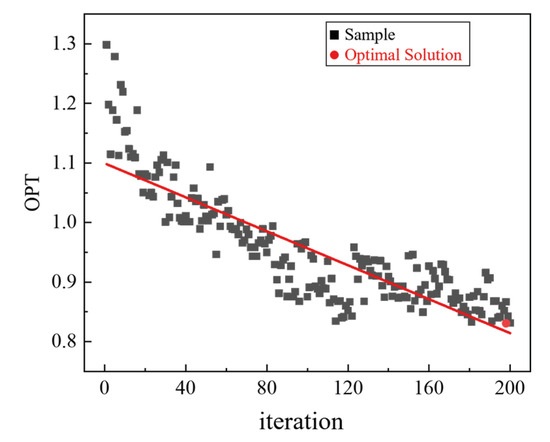
Figure 14.
Optimize the solution set.
As shown in Figure 15, within the optimization solution set comprising 200 individuals, diverse correlations exist between the design variables and the optimization objective. Regarding the design variable “Skeg-fullness”, an increase in its value leads to a decrease in the optimization objective value, thereby enhancing the optimization efficacy. In contrast, the remaining three variables exhibit opposing trends to varying extents; specifically, a reduction in their values corresponds to a diminished optimization objective value and improved optimization outcomes. Notably, the correlation between △CP and the optimization objective is the most pronounced.
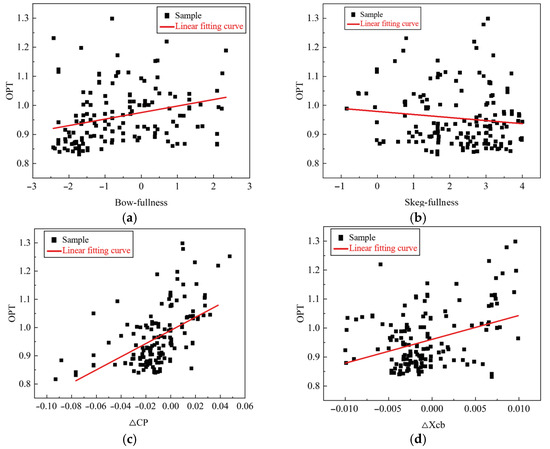
Figure 15.
Parameter correlation analysis. (a) Correlation between optimization objectives and Bow-fullness; (b) Correlation between optimization objectives and Skeg-fullness; (c) Correlation between optimization objectives and △CP; (d) Correlation between optimization objectives and △Xcb.
The hull form of the optimal solution within the optimization solution set and conduct a comparison between the hull form of the basis ship and the optimized ship. The results are shown in Figure 16.

Figure 16.
Comparison of hull profiles (basis ship: black curve; optimized ship: red curve). (a) Waterline comparison; (b) Longitudinal section comparison.
After optimization, Bow-fullness is −2.38746, Skeg-fullness is 3.36225, △CP is −0.018889, and △Xcb is −0.0031398. There are significant changes in the longitudinal section direction. In the waterline direction, the overall line of the optimized ship is thinner than that of the basis ship, and the change in the bow is greater than in the stern. The tail fin is fuller than the basis model, and the angle between the longitudinal section line and the waterline at B/4 becomes smaller.
5. Analysis of Hull Form Optimization Results
5.1. Calm Water Resistance Analysis
The optimization results of each resistance are shown in Table 13.

Table 13.
Calm water resistance calculation results.
Derived from the results regarding calm water resistance, it can be clearly observed that the performance of calm water resistance is ameliorated throughout the entire speed range encompassed within the design speed. Specifically, when compared to the basis ship, the optimization effect on calm water resistance of the optimized ship at the design speed witnesses a significant enhancement of 5.92%. As shown in Figure 17 and Figure 18, at the design speed, the side wave height of the optimized ship is remarkably lower than that of the basis ship, and simultaneously, the surface wave height of the optimized ship is also considerably reduced in contrast to that of the basis ship.
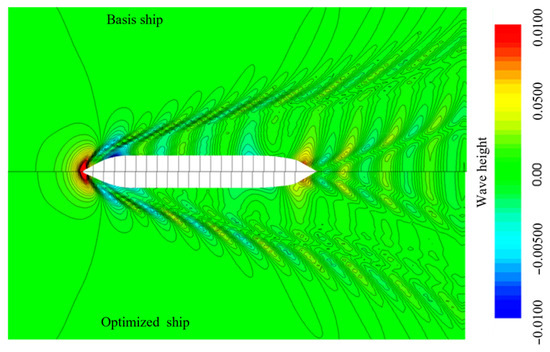
Figure 17.
Free surface comparison of basis and optimized ship.

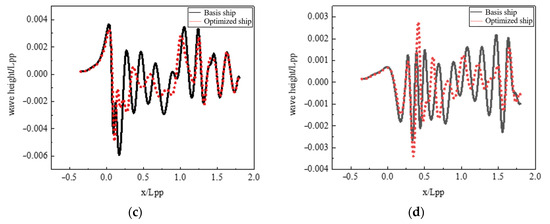
Figure 18.
Wave height of ships in different positions. (a) Ship traveling wave side wave height; (b) Free surface wave height; (c) Ship traveling wave height (y/Lpp = 0.1); (d) Ship traveling wave height (y/Lpp = 0.2).
5.2. Wave Added Resistance Analysis
The computed results pertaining to the wave added resistance at the design speed are exhibited in Table 14. Upon examination of the comparison results, it becomes evident that the wave-added resistance within each wave condition has been considerably enhanced. Considering the impacts exerted by factors such as sea state and voyage ratios, the optimization efficacy of the wave-added resistance is more pronounced as compared to that of the calm water optimization. Based on the ITTC two-parameter spectrum, the wave spectrum under different specific wave conditions in this article is shown in Figure 19.

Table 14.
Wave resistance calculation results.
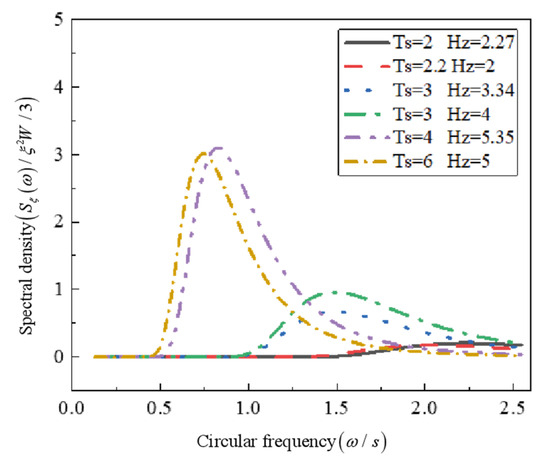
Figure 19.
ITTC two-parameter wave spectrum with different Hs and Tz.
5.3. Crushed Ice Resistance Analysis
During the optimization process, an empirical formula is used to calculate crushed ice resistance. The target ship bow is a straight stem, in which the angle y between the bow incidence angle wire of the longitudinal section and the waterline remains stable. The angle α between the longitudinal section line and the waterline at B/4 will change with the change in the hull surface. The initial angle α of the basis ship is 30°, and the angle of the optimized ship is 25.3327°. The correlation with the objective function is shown in Figure 20.
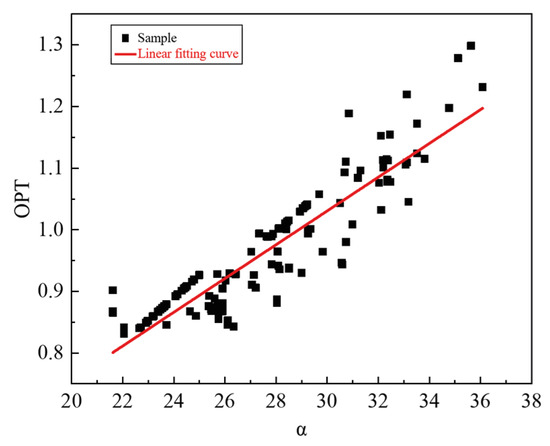
Figure 20.
Correlation between α and optimization goals.
The angle α between the longitudinal section line at B/4 and the waterline manifests a highly significant correlation with the overall resistance. The reduction in angle α engenders a more profound impact on other forms of environmental resistance as opposed to the resistance exerted by crushed ice resistance. Taking into account the strength of the bow, the angle between the longitudinal section line and the waterline at B/4 can be reasonably reduced for ships sailing in the ice area to achieve the effect of ship form drag reduction.
The CFD-DEM method was used to numerically simulate the crushed ice resistance of the target ship, and the scale ratio is 46.5. The size of the flow field is set to 18 m × 16 m × 12 m. There is no crushed ice seaway, and the crushed ice rink is generated from uniform distribution and fixed geometry size crushed ice. The sea ice material parameters are shown in Table 15. In the process of numerical simulation of ship-ice-water, there are many interactions between the multiphases. The numerical calculation of ship ice resistance takes into account the hull, crushed ice, water phase, and air phase. The phase interactions are shown in Table 16. The time step is set to 0.01.

Table 15.
Sea ice material parameters.

Table 16.
Interactions between phases.
The interaction between crushed ice and crushed ice and between the hull and crushed ice is simulated using a linear spring contact model; the interaction between crushed ice and water and between the hull and water is the interaction between the VOF phase and the solid. In the CFD-DEM coupling process of this paper, one-way coupling is adopted. The ice is regarded as a rigid body, and its breakage is not considered. Only the collision, extrusion, and pushing effects between the hull and the brash ice are considered. The translation and rotation in the phase motion are used to simulate the flipping and movement of the brash ice. The grid structure is illustrated in Figure 21, and the calculated work conditions are shown in Table 17.
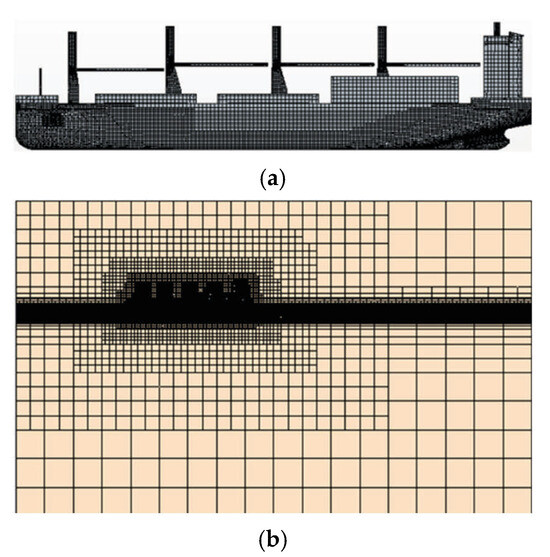
Figure 21.
Hull mesh and flow field longitudinal mesh. (a) Hull grid. (b) Grid of the longitudinal section of the flow field.

Table 17.
Ice-breaking resistance calculation condition.
While conducting CFD-DEM simulations for working condition 4 within this research, the resultant simulation data manifest an extremely scarce occurrence of ship-ice collision events, which can be attributed to the ice density of 10%. This phenomenon indicates that under the circumstance of such a low ice density, the effect of fragmented ice on the vessel’s navigation during the simulation is both trifling and negligible. Consequently, the simulated value of crushed ice resistance is approximately commensurate with that of calm water resistance.
In consideration of the actual navigation process, during the voyage in an ice region with a low ice density, the navigator typically adopts corresponding evasive maneuvers in accordance with the ice conditions and the ship’s performance to minimize contact and collision with ice, thereby ensuring the safety of navigation. Hence, only the ship-ice simulation results of the basis ship model and the optimized ship model under the other three ice conditions are compared herein, and the longitudinal and lateral ice load results of the hull are presented in Figure 22, Figure 23 and Figure 24.
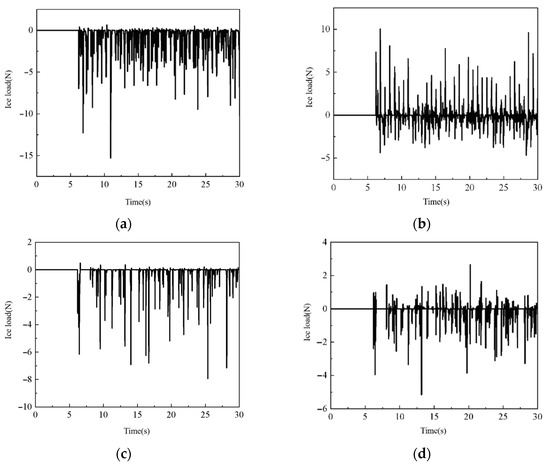
Figure 22.
Ice thickness 0.0215 m, density 40% of the ice load. (a) Longitudinal Force of basis ship in x-direction; (b) Longitudinal Force of basis ship in y-direction; (c) Longitudinal force in x-direction of the optimized ship. (d) Longitudinal force in y-direction of the optimized ship.
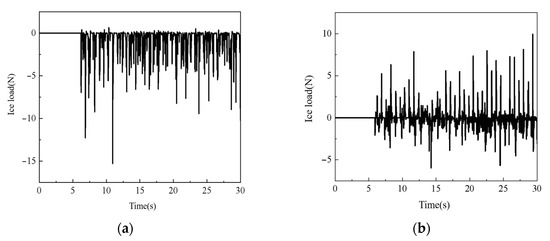
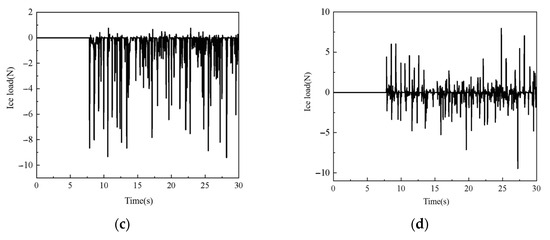
Figure 23.
Ice thickness 0.015 m, density 30% of the ice load. (a) Longitudinal Force of basis ship in x-direction; (b) Longitudinal Force of basis ship in y-direction; (c) Longitudinal force in x-direction of the optimized ship; (d) Longitudinal force in y-direction of the optimized ship.
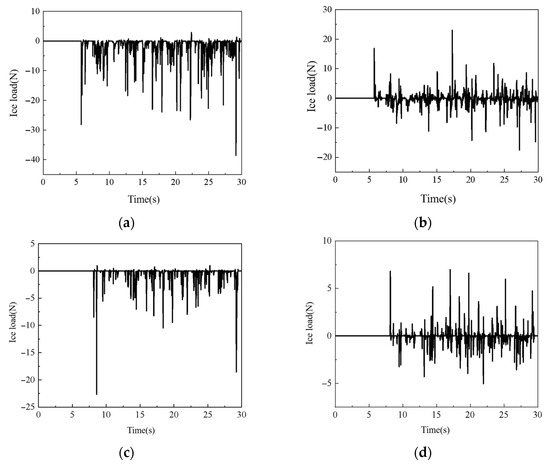
Figure 24.
Ice thickness 0.0107 m, density 50% of the ice load. (a) Longitudinal Force of basis ship in x-direction; (b) Longitudinal Force of basis ship in y-direction; (c) Longitudinal force in x-direction of the optimized ship; (d) Longitudinal force in y-direction of the optimized ship.
Through the time history curve of ice loads, it can be found that the longitudinal force of the hull in the x-direction under the action of the ship ice is 0.0107 m in the working condition, and the difference between the basis ship and the optimized ship is the most obvious when the density is 50%. There is also a certain difference in the y-direction lateral force.
When the ice thickness is 0.0107 m and the density is 50%, the simulation of ship-ice action is shown in Figure 25.
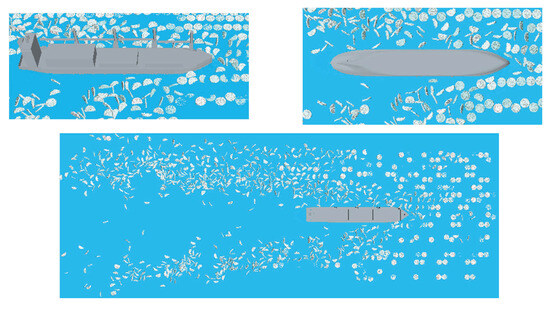
Figure 25.
The ice is 0.0107 m thick and 50% dense.
5.4. Ice-Covered Water Area Forecast Analysis
A ship propulsion system consists of a hull, propeller, ship host, and various transmission devices such as the main shaft, gearbox, etc. Its essence is an energy conversion system composed of a hull, a host, and a propeller. The effective thrust generated by the propeller overcomes the drag force on the ship. The relationship of the ship propulsion system is shown in Figure 26.

Figure 26.
Efficiency and Power Schematic.
Where ηg, ηS, ηR, η0, and ηH are the gearbox efficiency, shaft efficiency, relative rotational efficiency, propeller efficiency, and hull efficiency, respectively. PB, PS, PD, PT, and PE are the braking power, shaft power, transmission power, propulsive power, and effective power, respectively.
In ice-covered water areas, sea ice on the route will greatly affect the navigation of ships. Too low a speed will cause ice entrapment, while too high a speed will cause the main engine to run continuously overloaded. Therefore, forecasts are made for target ships under different ice conditions based on the main engine characteristics. Generally, the minimum speed limit of a low-speed diesel engine is 30% of the maximum continuous speed, and the maximum speed limit is 108% of the maximum continuous speed. The minimum power limit is 10% to 25% of the maximum continuous power. The general model selects the main engine equal torque curve as the maximum power limit curve.
The maximum power limit of the target ship’s main engine is shown in Formula (21):
where NMCR is the maximum continuous speed, MCR is the maximum continuous power, and C, C1, and C2 are correlation coefficients.
When the minimum speed of the main engine is set to 30% of the maximum continuous speed, the main engine power and speed limits are shown in Figure 27.
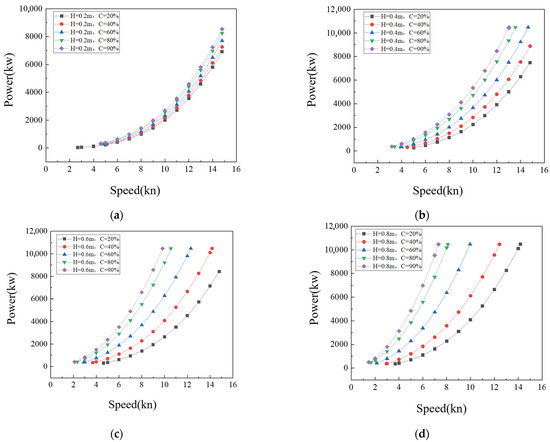
Figure 27.
Energy efficiency power under different ice. (a) Ice thickness 0.2 m; (b) Ice thickness 0.4 m; (c) Ice thickness 0.6 m; (d) Ice thickness 0.8 m.
Assuming that the target ship encounters broken ice and has no influence of wind and waves, the energy efficiency of the target ship under different ice conditions is predicted when it is sailing at a constant speed.
Selecting 60% density, the energy efficiency under different ice thicknesses is analyzed, and the results are shown in Figure 28. Similarly, the speed corresponds to the rotation speed. Under the influence of ice conditions, there is also an approximately cubic relationship between the speed and the rotation speed in the calm water phenomenon. The ice area is more susceptible to rotation speed and power restrictions. Under the same density, the thicker the ice, the lower the speed corresponding to the minimum fuel consumption rate. The more severe the ice condition, the lower the maximum navigable speed of the ship due to the influence of power and rotation speed, and the fuel consumption is significantly different from the fuel consumption at the same speed in open water. Small changes in speed in icy areas have a significant impact on fuel consumption.
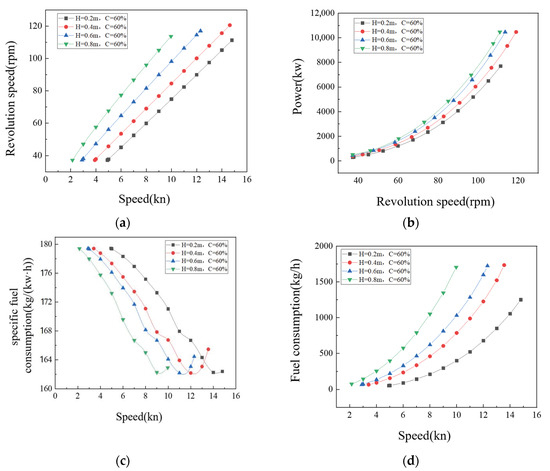
Figure 28.
Energy efficiency analysis for different ice thicknesses at 60% density. (a) Speed—Revolution speed. (b) Revolution speed—Power. (c) Speed—Specific fuel consumption. (d) Speed—Fuel consumption.
5.5. Comparison of Ship Energy Consumption at Design Speed
According to the drag simulation results of the optimized ship and the basis ship obtained on a specific route with the lowest total navigation drag in the previous article, we combine the simulation model to predict the hydrostatic power and fuel consumption forecast without the influence of wind and waves.
As can be seen in Figure 29, throughout the full speed range, the power and specific oil consumption of the optimized ship are lower than the basis ship. Additionally, with the augmentation of velocity, the differential between the main engine power and fuel consumption of the optimized ship and the basis ship at the corresponding velocity becomes more pronounced. Under the condition devoid of wind and wave interference, while navigating at the design speed, in line with the prediction outcomes yielded by the simulation model, the power of the optimized ship registers at 6042 kW, which is substantially lower than that of the basis ship, presenting a reduction rate of 7.1%. The rotational speed thereof is 104.47 rpm. Regarding fuel consumption, the hourly fuel consumption of the optimized ship amounts to 980.8 kg, which is 7.02% less than the hourly fuel consumption of 1054.9 kg of the basis ship at the design speed.
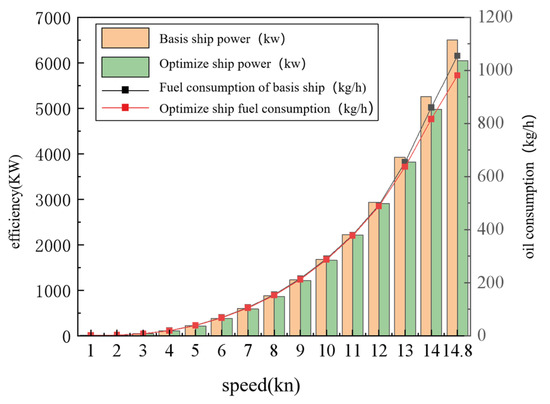
Figure 29.
Comparison of hydrostatic power and fuel consumption between basis and optimized ships.
During the maritime navigation process, wind and wave elements will induce an increment in the total resistance of the ship. Under the precondition that the main engine power remains invariant, the disparity in velocity between the scenarios of wind and waves and calm water is designated as the ship stall. Set the ship to sail in the sea state with a wind velocity of 12 m/s, a significant wave height of 4 m, a period of 3 s, and a wind direction angle and wave direction angle of 0°. The stall speed of the basis ship and the optimized ship under the influence of wind and waves is compared, and the results are shown in Figure 30.
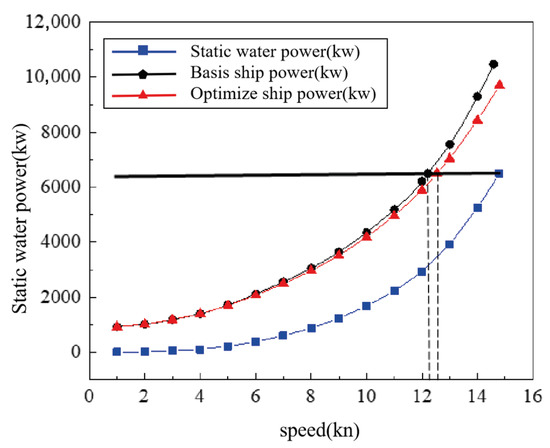
Figure 30.
Wind and wave stall comparison of basis and optimized ship.
The power of the basis ship when sailing at the design speed in the calm water area is taken as the boundary. Affected by wind and waves, the speed of the basis ship at this power is 12.21 kn, and the speed of the optimized ship at this power is 12.54 kn. The wind and wave coefficients of the two are 0.825 and 0.847, respectively.
Assuming that the ship is sailing in the ice area with an ice thickness of 0.5 m and a density of 50%, the wind speed is 12 m/s and the wind direction angle is 0°, and the power and fuel consumption of the optimized ship and the basis ship are also forecasted. The results are shown in Figure 31.
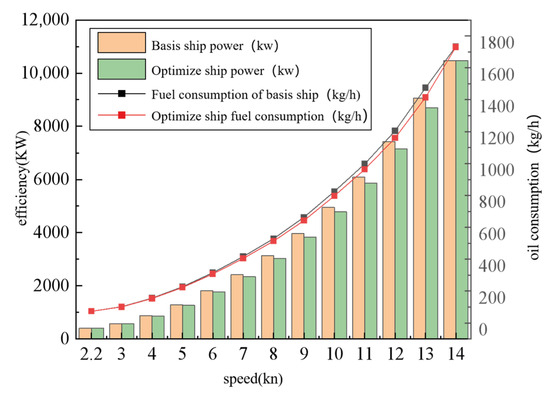
Figure 31.
Comparison of power and fuel consumption in the ice area between basis and optimized ships.
When sailing in icy waters, due to environmental resistance such as floating ice and speed and power limitations, the feasible range of the target ship’s speed is significantly reduced. The optimized ship not only has lower power and less fuel consumption than the basis ship at the corresponding speed but also has a slightly higher feasible range than the basis ship. Generally, in order to ensure safety during actual navigation, a conservative speed is usually chosen, and the power and fuel consumption of the basis ship and the optimized ship are closer, but the fuel consumption impact caused by changes in the speed of the ice area waters is still significant.
6. Conclusions
In this paper, we complete the hybrid reconstruction of the hull surface, determine the design variables, and apply the optimization theory and genetic algorithm to optimize the resistance of parametric hull form. Through the above work, the following conclusions can be obtained:
- (1)
- Based on the sea conditions of the route, the interpolation data extraction was carried out to obtain the wind, wave, ice conditions, and voyage data of the northeast route across the Arctic from Lianyungang to Europe in October 2019, which has certain reference value for the analysis of specific routes.
- (2)
- Based on the scenario analysis mode and the mixed deformation control of the hull surface, the resistance optimization scheme of the ice-class ship in the environment of multiple ice conditions and wind and waves was constructed, and the energy consumption of the ship shape optimization results was compared and evaluated by simulation model. This process provides certain reference value and research significance for the design, operation, and management of ice-class ships for the purpose of energy conservation and emission reduction.
The final results show that the hull form optimization process in this paper can achieve a good balance for navigation in both ice areas and ice-free areas. The optimization effect of the hull form with the lowest total resistance reaches 16.921%. Hull form optimization can bring considerable energy consumption reduction: At the design speed, the hydrostatic power and hourly fuel consumption are reduced by 7.1% and 7.02%, respectively. In the future, we will conduct fuel consumption simulation of ice-class ships based on more practical navigation record data, build a more comprehensive and integrated multi-target optimization platform for ice-class ships, and assist in the relevant research on green ice-class ships.
Author Contributions
Conceptualization, Y.L. and X.C.; methodology, Y.L.; formal analysis, X.P. and L.A.; data curation, Y.L. and X.C.; writing—original draft preparation, S.L., Y.L., X.P. and X.C.; writing—review and editing, X.P., L.A. and X.C.; supervision, J.W. and Y.L.; project administration, Y.L. All authors have read and agreed to the published version of the manuscript.
Funding
This study is supported by the National Natural Science Foundation of China General Project (No. 52171293), the Fundamental Research Funds for the Central Universities (No. 3132025117 and No. 3132023516), and the Natural Science Foundation of Hubei Province (2023AFB379).
Data Availability Statement
The data presented in this study are available in this article (tables and figures).
Conflicts of Interest
The authors declare no conflicts of interest.
References
- Lu, Y.; Gu, Z.; Liu, S.; Wu, C.; Shao, W.; Li, C. Research on Main Engine Power of Transport Ship with Different Bows in Ice Area According to EEDI Regulation. J. Mar. Sci. Eng. 2021, 9, 1241. [Google Scholar]
- IMO, M. Guide Lines on Survey and Certificaion of the Energy Efficiency Design Index (EEDI). MEPC 2012, 63, 23. [Google Scholar]
- Polakis, M.; Zachariadis, P.; de Kat, J.O. The Energy Efficiency Design Index (EEDI). In Sustainable Shipping: A Cross-Disciplinary View; Springer: Cham, Switzerlands, 2019; pp. 93–135. [Google Scholar]
- Yang, B.; Zhang, G.; Rao, H.; Wang, S.; Yang, B.; Sun, Z. Numerical Simulation of the Maneuvering Performance of Ships in Broken Ice Area. Ocean Eng. 2024, 294, 116783. [Google Scholar] [CrossRef]
- Chen, J.; Kang, S.; Chen, C.; You, Q.; Du, W.; Xu, M.; Zhong, X.; Zhang, W.; Chen, J. Changes in Sea Ice and Future Accessibility along the Arctic Northeast Passage. Glob. Planet. Change 2020, 195, 103319. [Google Scholar] [CrossRef]
- Landy, J.C.; Ehn, J.K.; Babb, D.G.; Thériault, N.; Barber, D.G. Sea Ice Thickness in the Eastern Canadian Arctic: Hudson Bay Complex & Baffin Bay. Remote Sens. Environ. 2017, 200, 281–294. [Google Scholar] [CrossRef]
- Ji, Q.; Li, B.; Pang, X.; Zhao, X.; Lei, R. Arctic Sea Ice Density Observation and Its Impact on Sea Ice Thickness Retrieval from CryoSat–2. Cold Reg. Sci. Technol. 2021, 181, 103177. [Google Scholar] [CrossRef]
- Earle, M. Development of Algorithms for Separation of Sea and Swell; National Data Buoy Center Tech Rep MEC-87-1; National Data Buoy Center: Hancock County, IN, USA, 1984; Volume 53, pp. 1–53. [Google Scholar]
- Yang, J.; Zhang, J.; Wang, G. Analysis of Arctic seas surface wind field and ocean wave remote sensing observation capability. Haiyang Xuebao 2018, 40, 105–115. [Google Scholar]
- Hino, T. Shape Optimization of Practical Ship Hull Forms Using Navier-Stokes Analysis. In Proceedings of the 7th International Confernce on Numerical Ship Hydro, Nantes, France, 19–22 July 1999. [Google Scholar]
- Fujii, H. Experimental Study on the Resistance Increase of a Ship in Regular Oblique Waves. In Proceedings of the 14th ITTC, Ottawa, ON, Canada, 11 September 1975; Volume 4, pp. 351–360. [Google Scholar]
- Joncquez, S.A.G.; Bingham, H.; Andersen, P. Validation of added resistance computations by a potential flow boundary element method. In Proceedings of the 27th Symposium on Naval Hydrodynamics, Seoul, Republic of Korea, 5–10 October 2008. [Google Scholar]
- Seo, M.-G.; Park, D.-M.; Yang, K.-K.; Kim, Y. Comparative Study on Computation of Ship Added Resistance in Waves. Ocean Eng. 2013, 73, 1–15. [Google Scholar] [CrossRef]
- Dai, Y.; Huang, D. The Near-field and Far-field Formulaefor the Added Resistance of Ships. J. Harbin Eng. Univ. 1994, 1–5. [Google Scholar]
- Wei, Y.; Chen, X.; Wang, J.; Wan, D. Multi-Objective Hull Form Optimization Utilizing Sequential Sampling Optimization Method. Ocean Eng. 2024, 310, 118667. [Google Scholar] [CrossRef]
- Huang, F.; Wang, L.; Yang, C. Hull Form Optimization for Reduced Drag and Improved Seakeeping Using a Surrogate-Based Method. In Proceedings of the ISOPE International Ocean and Polar Engineering Conference, Big Island, HI, USA, 21–26 June 2015. ISOPE-I-15-846. [Google Scholar]
- Pinto, A.; Peri, D.; Campana, E.F. Multiobjective Optimization of a Containership Using Deterministic Particle Swarm Optimization. J. Ship Res. 2007, 51, 217–228. [Google Scholar]
- Duan, F.; Zhang, L.; Chen, G.; Jiang, H.; Zhnag, Q. Polar vessel hullform design based on the multi-objective optimization NSGA II. Chin. J. Ship Res. 2017, 12, 66–72. [Google Scholar]
- Cheng, H.; Liu, X.; Li, B. Study on Multidisciplinary Optimization for Conceptual Design of Ice-Going Ships. Shipbuild. China 2015, 56, 124–130. [Google Scholar]
- Chen, C.; Liu, Y.; He, Y.; Zhang, W.; Zheng, G. Collaborative Optimization Design of Ice Resistance and Calm Water Resistance of a Polar Research Icebreaker. SHIP Eng. 2022, 44, 31–35, 48. [Google Scholar] [CrossRef]
- Rupp, K.; Hympendahl, O. Combination of Open Water and Icebreaking Performance of Ships. In Proceedings of the International Conference on Port and Ocean Engineering Under Arctic Conditions, Trondheim, Norway, 16–19 June 2003. [Google Scholar]
- Kim, H.-S.; Ha, M.-K.; Ahn, D.; Molyneux, D. Hull Form Designs for Icebreaking Tankers. In Proceedings of the SNAME International Conference and Exhibition on Performance of Ships and Structures in Ice, SNAME, Banff, AB, Canada, 16–19 July 2006; p. D031S008R001. [Google Scholar]
- Gu, Z. Optimized Design of Bow Line Based on Real Sea Conditions of Polar. Master’s Thesis, Dalian Maritime University, Dalian, China, 2024. [Google Scholar]
- Wang, S.; Liu, G. Efficient ship hull multi-objective optimization method considering ice resistance and calm water resistance. Chin. J. Ship Res. 2024, 19, 97–107. [Google Scholar] [CrossRef]
- Pan, S. Study on Optimization of Resistance Performance of an Icebreaker. Master’s Thesis, Harbin Engineering University, Harbin, China, 2023. [Google Scholar]
- Daidola, J.; Graham, D.; Chandrash, L. A Simulation Program for Vessel’s Maneuvering at Slow Speeds. In Proceedings of the Ship Technology and Research Symposium (STAR), 11th, Portland, OR, USA, 21–23 May 1986. [Google Scholar]
- Isherwood, R. Wind Resistance of Merchant Ships. Trans. RINA 1973, 115, 327–338. [Google Scholar]
- Huang, L.; Tuhkuri, J.; Igrec, B.; Li, M.; Stagonas, D.; Toffoli, A.; Cardiff, P.; Thomas, G. Ship Resistance When Operating in Floating Ice Floes: A Combined CFD&DEM Approach. Mar. Struct. 2020, 74, 102817. [Google Scholar]
Disclaimer/Publisher’s Note: The statements, opinions and data contained in all publications are solely those of the individual author(s) and contributor(s) and not of MDPI and/or the editor(s). MDPI and/or the editor(s) disclaim responsibility for any injury to people or property resulting from any ideas, methods, instructions or products referred to in the content. |
© 2025 by the authors. Licensee MDPI, Basel, Switzerland. This article is an open access article distributed under the terms and conditions of the Creative Commons Attribution (CC BY) license (https://creativecommons.org/licenses/by/4.0/).